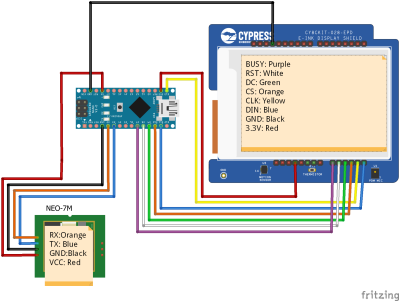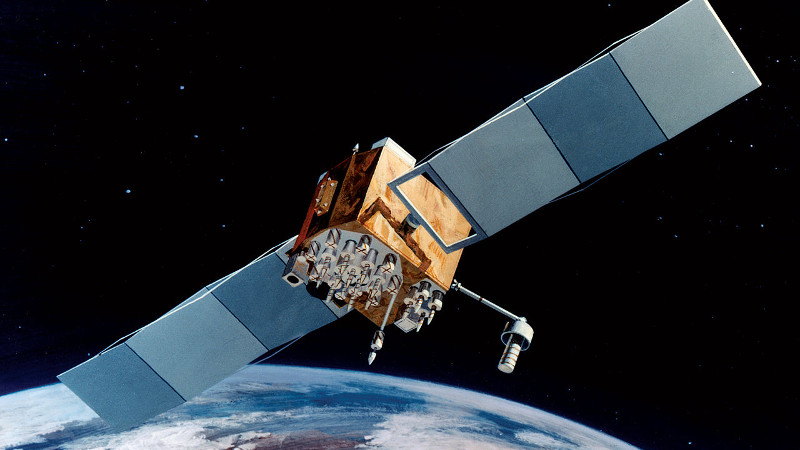 If you mention a clock that receives its time via radio, most people will think of one taking a long wave signal from a station such as WWVB, MSF, or DCF77. A more recent trend however has been for clocks that set themselves from orbiting navigation satellites, and an example comes to us from [KK99]. It’s a relatively simple hardware build in that it is simply an Arduino Nano, GPS module, and e-ink display module wired together, but it provides an interesting exercise in running through the code required for a GPS clock.
If you mention a clock that receives its time via radio, most people will think of one taking a long wave signal from a station such as WWVB, MSF, or DCF77. A more recent trend however has been for clocks that set themselves from orbiting navigation satellites, and an example comes to us from [KK99]. It’s a relatively simple hardware build in that it is simply an Arduino Nano, GPS module, and e-ink display module wired together, but it provides an interesting exercise in running through the code required for a GPS clock.
It does however give us a chance to remember the story from last year surrounding WWVB, as a budget proposal last year mooted the prospect of the closure of the Fort-Collins-based time signal transmitter. Were that to happen an estimated 50 million American clocks would lose their reference, and while their owners could always update them manually, there will always be time-based systems to which that won’t be applied for whatever reason. Europeans meanwhile are safe in their time transmissions for now , but in case they think they have their mains grid to fall back on it’s worth remembering the time they lost six seconds.
GPS satellite image: USAF [Public domain].



















Reminds me I wanted to hack this Goodwill Store LaCrosse Model 617-1485B with an external antenna input for the time signal. I still need to read into more and am wondering about a GPS module emulator option too so can use for whatever time source.
Interesting is I went to Barnes & Noble and opened up the lone Nuts and Volts magazine edition (Jan./Feb. 1019) and found an Internet Digital Clock project that seems to be reminding me of this looming project with another option that is to use an internet time source that never even crossed my mind ever.
(Jan./Feb. 1019)
I’m thinking of the monks that labored by the light of a tallow candle, over their tables making that issue available for future generations.
Is the one you saw an Illuminated Copy on vellum?
B^)
First laugh of the day. Hopefully sign of a good day ahead.
I am in the process of rebuilding my “TrackerJacker”
instead of an LCD I was going to use an ePaper display, the AdaFruit ones look cool, but there are dire warnings about updating faster than 180 seconds
which would make for a “dull” clock, compass, GPS
are ePaper displays not suited to real time stuff?
Usually e-ink can be updated more often than that, once per second shouldn’t be a problem as long as the driver keeps track of the per-pixel balance to keep it from accumulating charge. If the driver repeatedly forces a pixel towards white even though it is already white, the charge will build up and you’ll get a white ghost image later. Kind of like burn-in in CRT displays.
Maybe it’s either related to those Adafruit displays being tri-color, or maybe their display driver takes some shortcuts that cause charge buildup.
I’m more worried about the compass “mode”
that updates quickly
the tri colour ones might be better for cumulative displays, distance traveled, altitude change, that kind of thing
three color ones are meant for static labels or such… updating a three color display is really much slower than a monochrome one…
“i tortured my eink and this is what happened” would make a great hackaday article.
so don’t use an ePaper display for a clock or compass??
How about the Sun? A sundial with an array of photo-whatever used to detect both position of the shadow and speed at which the Earth rotates can.be used to control a PLL?
What do you mean Europeans are safe? DCF77 is German, does not reach where i’m at.
There is a similar french time signal on 162kHz and an UK time signal on 60kHz.
In Italy there is a shortwave signal on 10 and 15 MHz.
In Spain they transmit the time once per day on 15006kHz and 4998kHz.
Reply to Daniel:
Did not know there are so many. None of them reach here where i am and we don’t have our own.
Holy scheisse this new comment system is complete crap!
Might want to fix the discrepancy.
Text says: the time they lost six seconds.
Thge last part of the URL says: europe-loses-six-minutes-due-to-sagging-frequency-and-international-politics
Love the idea of using a gps module for time synchronization. I wonder however, do indoor environments not block the gps signal too much to be usefull?
GPS is highly directional. (No pun intended.). Multiple transmitters all around. In a typical house at least one signal is likely to penitrate into any given room. While multiple signals are requited for navigation (the more the better) only ONE signal would be required for use as a time reference.